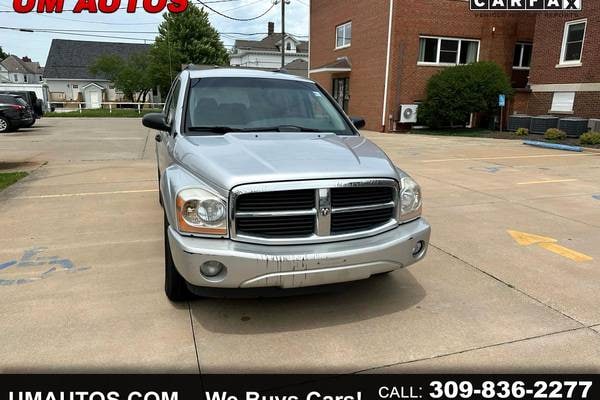2006 Dodge Durango Review
Price Estimate: $1,300 - $2,068
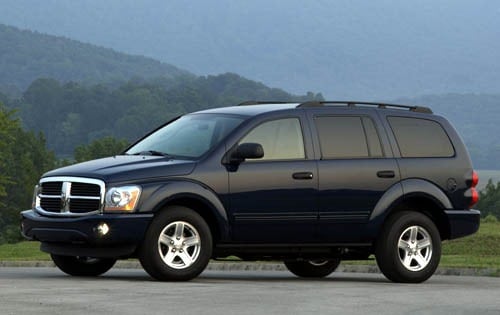 View 53 more photos
View 53 more photos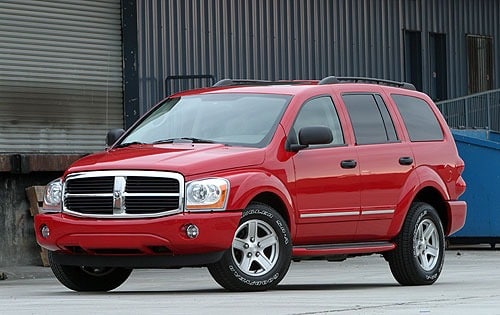 View 53 more photos
View 53 more photos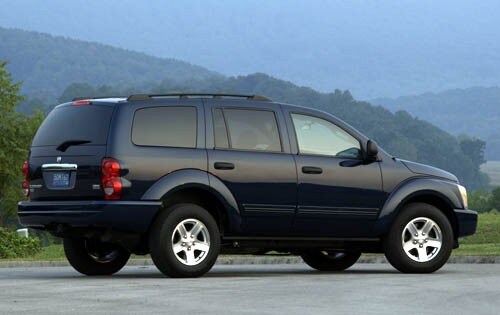 View 53 more photos
View 53 more photos View 53 more photos
View 53 more photos View 53 more photos
View 53 more photos+49
Oops, we can’t seem to locate you.
Please enter U.S. ZIP code to see vehicles for sale
Edmunds' Expert Review
by the Edmunds Experts
Pros
- Strong V8 engines, agile handling, excellent ride quality, capable off-road, lots of cargo capacity, simple controls.
Cons
- Lousy mileage, sloppy fit and finish, needs more second-row legroom and storage.
What’s new
The 5.7-liter Hemi V8 gains a multidisplacement cylinder management system, which boosts fuel economy up to 20 percent in certain driving situations. Wheel choices have been revised, and 17-inch alloys are now standard. Stability control, a power rear liftgate and remote vehicle start system are newly optional. A three-passenger 60/40-split third-row seat is now optional on the SLT and standard on the Limited model, raising maximum seating capacity to eight.
Edmunds says
With its tough-truck styling, available Hemi V8 and roomy interior, the 2006 Dodge Durango offers an appealing combination of power, comfort and utility. If you don't mind its big thirst at the pump, it's a great value.
For sale nearby
25 listings
- 117,476 miles
- No accidents, 2 owners, rental vehicle
- 7 Seats, 12 City / 17 Hwy MPG
- UM Autos (517 mi away)
- AWD/4WD
- Third-row seating
- Power Driver Seat
- Rear Bench Seats
- Fold Flat Rear Seats
Close
Located in Macomb, IL
UM Autos Nadir Khan 230 W Jackson Macomb, IL 61455 3**-8**-2*** 2006 DODGE DURANGO SLT, 117,476 MILES, 2ND OWNER VEHICLE, 4.7 L V8 ENGINE, 4X4, 3RD RO...
AutoCheck Vehicle History Summary
Accident Free Vehicle: Yes
Personal Use Only: No
History Provider: AutoCheck
Title Details: Clean Title
Salvage Vehicle: No
Frame Damage: No
Theft History: No
Lemon Status: No
Free History Report: No
Features and Specs:
14 Combined MPG (12 City/17 Highway)
Listing Information:
VIN: 1D4HB48N46F151985
Stock: 117476
Certified Pre-Owned: No
Listed since: 04-08-2025- 140,710 miles
- 1 accident, 3 owners, personal use only
- 7 Seats
- Zeller Motor Chrysler Dodge Jeep Ram (620 mi away)
- Navigation
- Leather Seats
- Sunroof/Moonroof
- Third-row seating
- Power Driver Seat
Close
Located in Arkansas City, KS
The moment you walk into Zeller Motors in Arkansas City KS, you're going to feel like part of the family. For more than 50 years, we've been offering ...
AutoCheck Vehicle History Summary
Accident Free Vehicle: No
Personal Use Only: Yes
History Provider: AutoCheck
Title Details: Clean Title
Salvage Vehicle: No
Frame Damage: No
Theft History: No
Lemon Status: No
Free History Report: No
Features and Specs:
Listing Information:
VIN: 1D4HD58246F174172
Stock: 6F174172
Certified Pre-Owned: No
Listed since: 06-20-2025
Vehicle overview
Back in 1998, if you wanted eight-passenger capability in an SUV, it meant having to step up to a full-size beast, such as the Expedition or Suburban. Smelling an opportunity, Dodge designed its Durango SUV to fill the gap between midsize SUVs and their larger brethren. The original Durango was based on the Dakota pickup and offered a third-row seat that the midsize SUVs of the day didn't.
Power came from either a standard 5.2-liter V8 or an optional 5.9-liter V8, and all first-year Dodge Durango models had four-wheel drive. As the years went on, a two-wheel-drive version became available, a more efficient 4.7-liter V8 replaced the old 5.2, and a sporty R/T model debuted. A completely redesigned second-generation Durango debuted in 2004, and Dodge's SUV grew in virtually every dimension. Styling cues include Dodge's signature cross-hair grille and aggressive wheel arches. The cabin features more comfort for second-row passengers, thanks to added room, reclining seatbacks and options like secondary climate controls and a DVD entertainment system.
Unfortunately, adults will likely find that the second row's available legroom is rather tight. As on the original, a kid-friendly third-row seat is available. Previously, this bench could accommodate just two, but a new 60/40-split design for 2006 makes it possible to squeeze an extra child back there on carpool days, allowing the Durango to seat eight passengers total. With a maximum towing capacity of 8,950 pounds, the Dodge Durango can pull more weight than most full-size SUVs. The chassis boasts a fully hydroformed frame that promises greater structural integrity for better ride and handling characteristics along with a decreased chance of rattles and squeaks cropping up down the road. With its spacious cabin, powerful engine lineup and distinctive looks, the 2006 Dodge Durango is an SUV that deserves careful consideration, particularly if you've got a big family and tow a trailer.
Performance & mpg
The standard power plant for 2WD Durango SXT and SLT models is a 3.7-liter V6 that supplies 210 horsepower and 235 pound-feet of torque. Standard on 2WD Limiteds and all 4WD models is a 4.7-liter V8 with 230 horses and 290 lb-ft. For maximum towing and hauling power, an optional 5.7-liter multidisplacement Hemi V8 is available that generates 335 hp and 370 lb-ft of torque. All three engines use automatic transmissions; the V6 runs through a four-speed gearbox, while the V8s have five-speed units with a tow-haul mode. Properly equipped, a Hemi Durango has an 8,950-pound tow rating.
Safety
Four-wheel antilock disc brakes are standard. Side curtain airbags that cover all three rows are optional on all models. Stability control is standard on the Limited and optional on all other Durangos. Power-adjustable pedals are standard on the Limited and optional on the SLT. In government crash testing, the Dodge Durango earned a perfect five-star rating for frontal impacts.
Driving
In spite of its generous proportions, the Durango manages to deliver both a smooth, composed ride and nimble handling around corners. Dodge's SUV is similarly adept in off-road situations, offering plenty of wheel travel and a playful demeanor. The base V6 provides barely adequate power, so we recommend the 4.7-liter V8 for most buyers. Equipped with the top-of-the-line Hemi V8, the 2006 Dodge Durango is one of the quickest SUVs in its price range.
Interior
Modern in design and functional throughout, the seven-passenger Dodge Durango was designed with family usage in mind. Depending on which third-row seat option you select, it can seat seven or eight passengers. The front seats are roomy and comfortable, but adults will find legroom and storage areas in short supply in the second row. The third-row seat is suited for kids only. Cargo capacity should be more than ample for most buyers; there's 67 cubic feet when the third seat is folded into the floor. Other family-friendly extras include a DVD entertainment system, a 384-watt Infinity sound system and satellite radio.
2006 Dodge Durango models
The four-door Dodge Durango SUV is offered in three trim levels -- SXT, SLT and top-of-the-line Limited -- with either two- or four-wheel drive. The SXT comes standard with power windows, locks and mirrors; air conditioning; heated seats; alloy wheels; an AM/FM/CD stereo; and cruise control. The SLT adds a power driver seat, rear air conditioning, wood grain cabin accents, body-color front and rear fascias, foglamps and a two-passenger third-row seat. Optional on the SLT is the Adventurer package, which includes a roof rack, tubular side steps, slush mats, a cargo liner and organizer, and unique alloy wheels. Spring for the Limited and you'll get leather seating, automatic climate control, a three-passenger third-row seat, a power rear hatch, a nine-speaker Infinity audio system with steering wheel-mounted controls, auto-dimming mirrors, universal garage opener, a memory system (for the driver seat, mirror, stereo and climate settings), and a security system.
Compare 2006 Dodge Durango trim levels
Helpful trims summary and side-by-side comparison chart
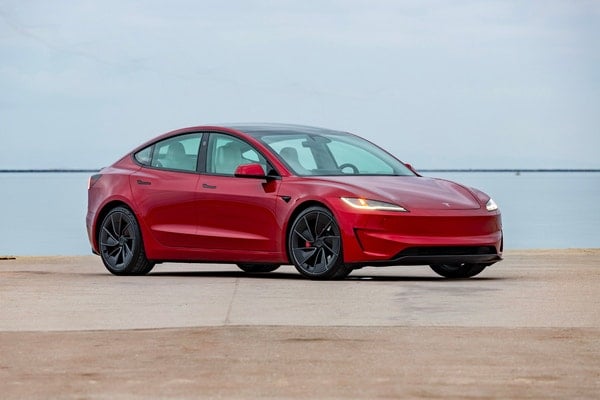
Our 2024 Tesla Model 3 Performance Is an Edmunds U-Drags Assassin
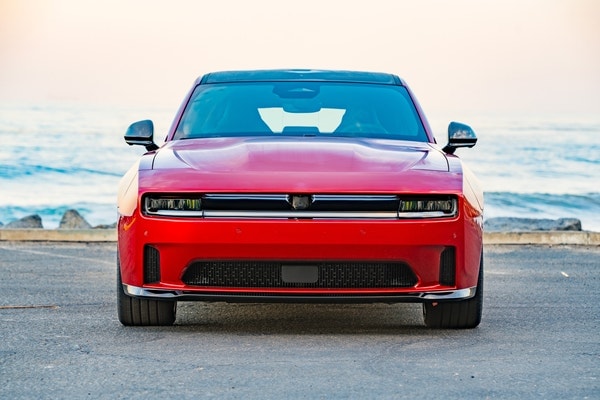
Here's What Really Happened With Our Dodge Charger EV's Unintended Acceleration
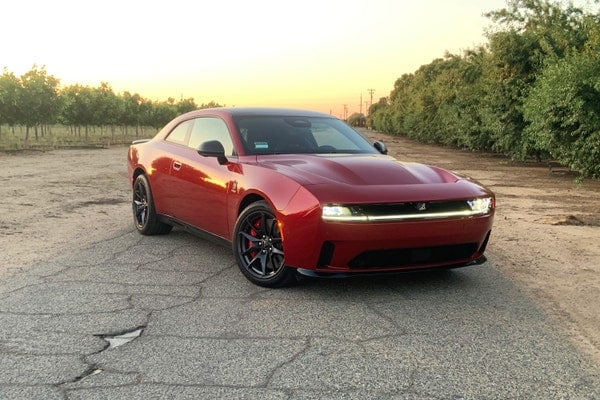
Yikes! Our Dodge Charger Daytona EV Had a Curious Case of Unintended Acceleration
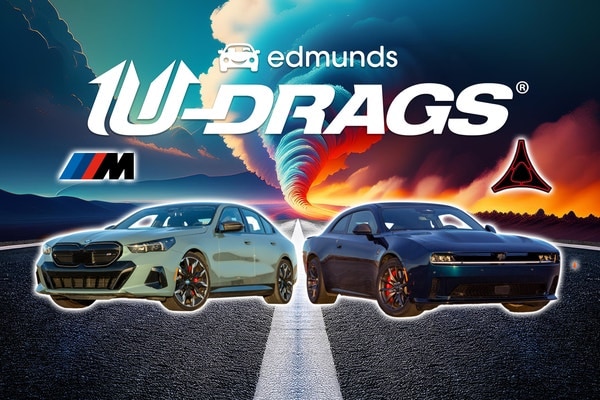
BMW i5 M60 vs. Dodge Charger Daytona: Big EVs Battle in Edmunds U-Drags
Cost to Drive
Monthly estimates based on costs in North Dakota
$245/mo for Durango SXT
Durango SXT
vs
$232/mo
Avg. Large SUV
See Edmunds pricing data
Has Your Car's Value Changed?
Used car values are constantly changing. Edmunds lets you track your vehicle's value over time so you can decide when to sell or trade in.

Dodge Durango Owner Reviews
Most Helpful Owner Reviews
Trending topics
11 Month Reveiw
4 out of 5 starsJim, 08/03/2016
2006 Dodge Durango Limited 4dr SUV 4WD (4.7L 8cyl 5A)
I purchased my Durango Limited with the 5.7L motor (why isn't that an option for Model Selection?) Anyway, after putting 13k miles on it in the past 11 months I am overall happy. I'm 6', 300lbs and I'm quite comfortable in it. I've had as many as six adult passengers in the SUV and no one has complained about leg room or comfort. My only complaints so far are; (1) could be less hard … plastic in the interior - the front seat belt covers were missing when I bought the SUV and the pouch on the back of the driver's seat was gone. (2) The left rear quarter panel seem to have rust issues just behind the fuel door. I see this on many Gen2 Durangos. (3) Both the 4.7L and 5.7L motors are very susceptible to exhaust manifold leakage mainly due to manifold bolts breaking. (4) If I’m not careful, I get overflow/spit-back when fueling up. There was a recall for this but I keep forgetting to check if my Durango still qualifies being that it’s 10 years old now.
142,000 Reliable Miles
5 out of 5 starsMike Cee, 11/18/2016
2006 Dodge Durango SLT 4dr SUV 4WD (4.7L 8cyl 5A)
We purchased our 2006 Durango just over 10 years ago when it was new. It's been completely reliable and has never let us down. It makes it through deep snow to our rural home on those winter nights. Interior, while not fancy, is very usable and well laid out. The fuel mileage is what you'd expect on a full size 4X4 SUV with a V8. We've taken it on a number of trips and it's very … comfortable.
Love my Durango!
5 out of 5 starsLove it!, 11/07/2005
2006 Dodge Durango Limited 4dr SUV (4.7L 8cyl 5A)
I just picked this vehicle up and it's a dream. The HEMI is very responsive and it drives like a dream. Kind of like driving a recliner down the highway. Got the loaded out Limited with navigation, 6 disk changer, Sirus Satellite radio and DVD player. It's Inferno Red which I guess is a new color for this year. Heated seats, love the auto climate control too. I has the tip start … feature to which works pretty good. I always have a confident feeling while driving this Durango. I've read other posts here before deciding to buy and a few listed gas mileage specs. I've got over 1000 miles and the average economy on the highway is between 18 and 20 mpg. I supposed a heavy foot could change that
Hillspot
4.75 out of 5 starshillspot, 11/29/2006
2006 Dodge Durango SXT 4dr SUV (3.7L 6cyl 4A)
The comfort for a family of six is great. The kids have a lot of room to maneuver around and not be crowded.
2006 Durango Highlights
SXT
| Base MSRP Excludes Destination Fee | $28,550 |
|---|---|
| Engine Type | Gas |
| Combined MPG | 16 MPG |
| Cost to Drive | $245/month |
| Seating | 5 seats |
| Cargo Capacity All Seats In Place | 68.4 cu.ft. |
rear wheel drive | |
| Warranty | 3 years / 36,000 miles |
Safety
Key safety features on the Durango include:
- Alarm
- Stability Control
NHTSA Overall Rating
The National Highway Transportation Safety Administration offers independent analysis.
- Frontal Barrier Crash RatingOverallNot RatedDriver5 / 5Passenger5 / 5
- Side Crash RatingOverallNot Rated
- Side Barrier RatingOverallNot RatedDriverNot RatedPassengerNot Rated
- Combined Side Barrier & Pole RatingsFront SeatNot RatedBack SeatNot Rated
- RolloverRollover3 / 5Dynamic Test ResultNo TipRisk Of RolloverNot Rated
People who viewed this also viewed
| 3.5 average Rating out of 24 reviews. |
| Starting at $40,050 |
| 4.3 average Rating out of 13 reviews. |
| Starting at $36,390 |
| 3.9 average Rating out of 36 reviews. |
| Starting at $40,200 |
Related Used 2006 Dodge Durango info
Vehicle reviews of used models
- Toyota Camry 2021 Review
- Acura Ilx 2020 Review
- Chevrolet Suburban 2020 Review
- BMW 5 Series 2020 Review
- Mitsubishi Mirage G4 2021 Review
Shop similar models
- Used Kia Telluride 2025
- Used Hyundai Palisade 2025
- Used Jeep Grand-cherokee 2025
- Used Chevrolet Traverse-limited 2024
Shop used vehicles in your area
- Used Dodge Durango 2011
- Used Dodge Durango 2012
- Used Dodge Durango 2013
- Used Dodge Durango 2014
- Used Dodge Durango 2015
- Used Dodge Durango 2016
- Used Dodge Durango 2017
- Used Dodge Durango 2018
- Used Dodge Durango 2019 For Sale
- Used Dodge Durango 2020
Popular new car reviews and ratings
- 2025 XC60
- New Dodge Ram Pickup 2500
- 2024 BMW 4 Series
- McLaren GTS 2025
- 2024 BMW X5 M
- 2024 3500
- Audi SQ7 2025
- New BMW X6
- New Cadillac ATS
- 2026 Volvo XC40 News
Research other models of Dodge
Research similar vehicles
Other models
- New Mercedes-Benz Cla-Class for Sale in Auburn Hills, MI
- Used Lexus GX-470 in Georgetown, TX 2009
- Used Audi A7 in Laurel, MS 2025
- Used BMW M2 in Madison Heights, MI 2025
- New Audi SQ5 for Sale in Norwich, CT
- Used Lexus RX-450HL in Louisville, KY 2022
- New Mercedes-Benz Eqs-Suv for Sale in Lewisburg, PA
- Used Plymouth Prowler in Taunton, MA 2001
- New Mazda Mx-5-Miata for Sale in Jackson, MS
- Used Porsche Panamera in Gainesville, TX 2025
